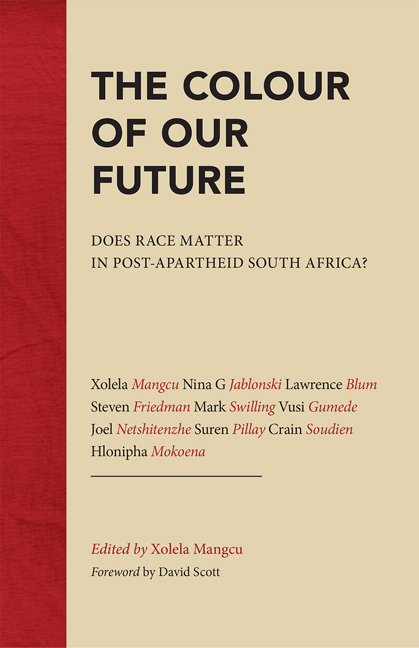Book contents
- Frontmatter
- Dedication
- Contents
- Figures and tables
- Acronyms and abbreviations
- Foreword
- Preface
- Chapter One What Moving Beyond Race Can Actually Mean: Towards a Joint Culture
- Chapter Two The Colour of Our Past and Present: The Evolution of Human Skin Pigmentation
- Chapter Three Races, Racialised Groups and Racial Identity: Perspectives from South Africa and the United States
- Chapter Four The Janus Face of the Past: Preserving and Resisting South African Path Dependence
- Chapter Five How Black is the Future of Green in South Africa's Urban Future?
- Chapter Six Inequality in Democratic South Africa
- Chapter Seven Interrogating the Concept and Dynamics of Race in Public Policy
- Chapter Eight Why I Am No Longer a Non-Racialist: Identity and Difference
- Chapter Nine Interrogating Transformation in South African Higher Education
- Chapter Ten The Black Interpreters and the Arch of History
- Notes
- Contributors
- Index
Chapter Ten - The Black Interpreters and the Arch of History
Published online by Cambridge University Press: 20 April 2018
- Frontmatter
- Dedication
- Contents
- Figures and tables
- Acronyms and abbreviations
- Foreword
- Preface
- Chapter One What Moving Beyond Race Can Actually Mean: Towards a Joint Culture
- Chapter Two The Colour of Our Past and Present: The Evolution of Human Skin Pigmentation
- Chapter Three Races, Racialised Groups and Racial Identity: Perspectives from South Africa and the United States
- Chapter Four The Janus Face of the Past: Preserving and Resisting South African Path Dependence
- Chapter Five How Black is the Future of Green in South Africa's Urban Future?
- Chapter Six Inequality in Democratic South Africa
- Chapter Seven Interrogating the Concept and Dynamics of Race in Public Policy
- Chapter Eight Why I Am No Longer a Non-Racialist: Identity and Difference
- Chapter Nine Interrogating Transformation in South African Higher Education
- Chapter Ten The Black Interpreters and the Arch of History
- Notes
- Contributors
- Index
Summary
In all epochs of the world's history, we shall find the Great Man to have been the indispensable saviour of his epoch; – the lightning, without which the fuel never would have burnt. The History of the World, I said already, was the Biography of Great Men.
Great men make history, but only such history as it is possible for them to make. Their freedom of achievement is limited by the necessities of their environment. To portray the limits of those necessities and the realization, complete or partial, of all possibilities, that is the true business of the historian.
The chief characteristic of the hero is sincerity. More sublime than grace, more authentic than reason, sincerity is a moral force that connects the actor to his action or belief or idea.
It is a truism of South African history that black people have been ‘invisible’ for centuries – erased out of history, erased out of place, erased out of cities, erased out of mind. It is also a truism that this erasure is no accident – it didn't just happen; it was part of the grander history of the colonisation of the southernmost tip of the African continent. It is in this state of being post-colonials that we as a ‘new generation’ of South Africans – Mandela's progeny, Generation X/Y, ‘Model Cs’, Born Frees, whatever epithet you care to throw at us – confront the ‘blank spaces’ of our country's history.
This chapter will be the meditation of a Generation Xer on how we can restore sight so that future generations can see themselves in ‘history’. It is based on the thought that the only way we can restore this lost sight is by assuming the role carved out for us by an earlier generation of Africans who themselves had to deal with the shock of watching themselves being erased. Their struggle to paint in, fill in, plaster over, colour in the experience of being a historical subject and a seeing being is our struggle. I shall call these earlier Africans the ‘black interpreters’.
However, inasmuch as their struggle is ours, this chapter will also argue that being a post-colony is not a period measured in time but an age: ‘As an age, the postcolony encloses multiple durées made up of discontinuities, reversals, inertias, and swings that overlay one another, interpenetrate one another, and envelope one another: an entanglement.’
- Type
- Chapter
- Information
- The Colour of Our FutureDoes race matter in post-apartheid South Africa?, pp. 169 - 184Publisher: Wits University PressPrint publication year: 2015

